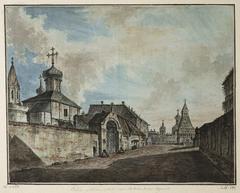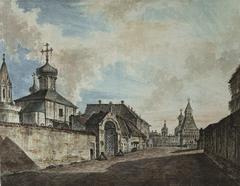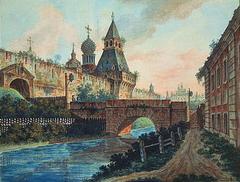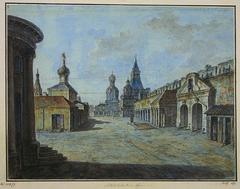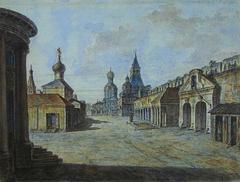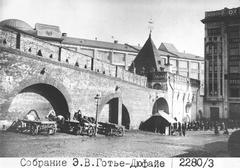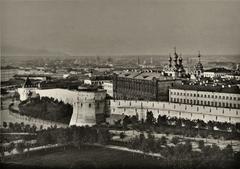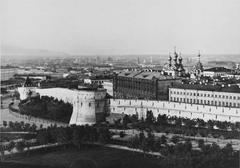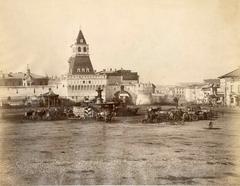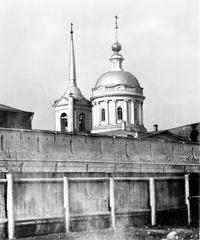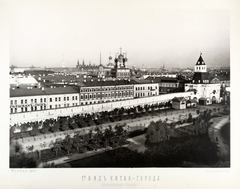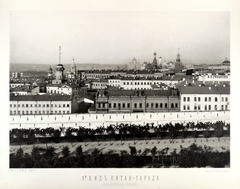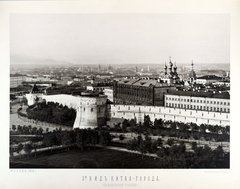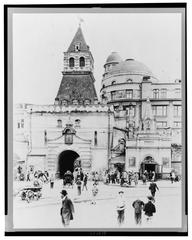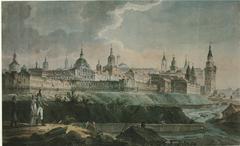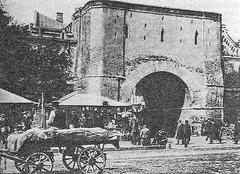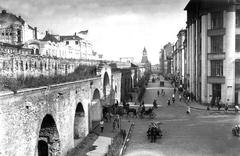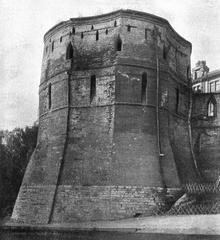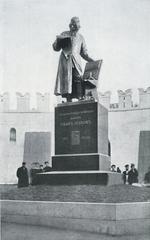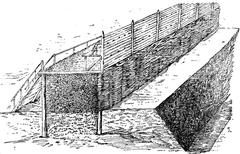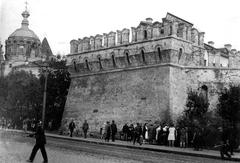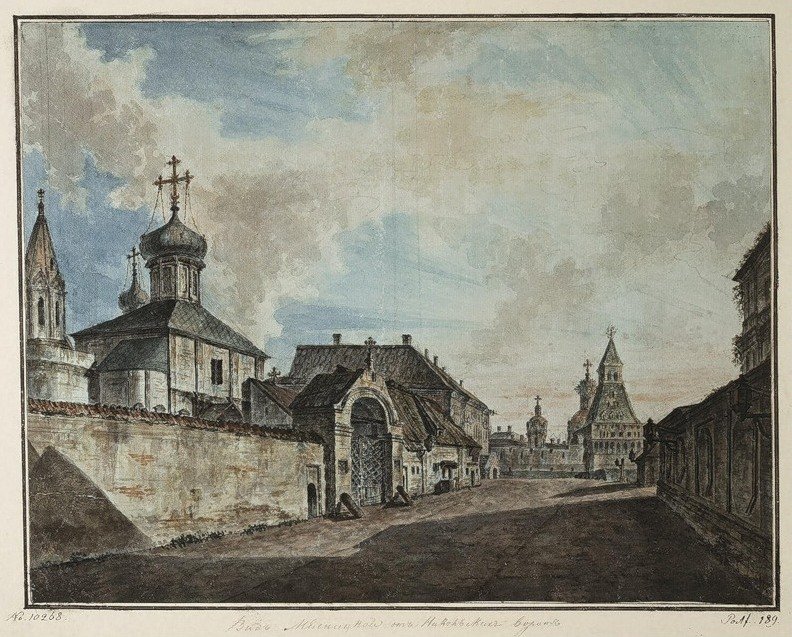
Kitai-Gorod Wall Moscow: Visiting Hours, Tickets, and In-Depth Historical Guide
Date: 15/06/2025
Introduction: The Enduring Legacy of the Kitai-Gorod Wall
The Kitai-Gorod Wall is a vivid testament to Moscow’s layered history, standing as a symbol of both the city’s medieval resilience and ongoing urban evolution. Built between 1535 and 1539 under Grand Prince Vasili III with the expertise of Italian architects, this formidable brick fortification once stretched approximately 2.6 kilometers, punctuated by up to 14 towers and several gates. Designed to protect Moscow’s commercial and administrative heart adjacent to the Kremlin and Red Square, the wall served as a “mini Kremlin,” blending military innovation with Russian architectural tradition (Moscow.info; Russia Beyond; Lonely Planet).
Today, surviving fragments near Zaryadye Park, Varvarka Street, and the Hotel Metropol offer visitors a rare opportunity to walk through centuries of Moscow’s evolution. The wall’s remnants highlight both Renaissance military architecture and the city’s ability to adapt through wars, modernization, and urban renewal (Advantour; Wikipedia). With most outdoor sections open year-round and free to access, the Kitai-Gorod district is a destination that seamlessly combines historic atmosphere, vibrant culture, and dynamic city life.
Guide Overview
This comprehensive guide covers:
- A historical overview and architectural analysis
- Details on visiting hours, tickets, and accessibility
- Highlights and unique visitor experiences
- Preservation efforts and ongoing challenges
- Practical travel tips and nearby attractions
- Frequently asked questions and resources
The History of the Kitai-Gorod Wall
Commissioned by Grand Prince Vasili III, the Kitai-Gorod Wall was constructed to fortify Moscow’s eastern approaches, especially as the city’s commercial activities flourished outside the Kremlin. Italian architects introduced advanced brickwork and Renaissance defensive features, including thick walls, machicolations, and robust towers. The wall’s height reached up to 8 meters and its thickness up to 4.5 meters at the base, making it one of Eastern Europe’s most formidable urban defenses of the 16th century (Russia Beyond).
Over time, the wall’s gates such as Iversky and Varvarka became integral to city life, serving ceremonial, religious, and commercial purposes. Although much of the wall was demolished during Stalin’s 1930s modernization drive, key sections and a handful of towers remain as enduring witnesses to Moscow’s past (Moscow.info).
Architectural Features and Surviving Remnants
Design and Structure
The wall showcases a unique blend of Russian and Renaissance military styles. Its brickwork is reinforced with limestone and features rare defensive elements like machicolations—overhangs with openings for dropping projectiles. Towers such as Varvarskaya and Ilyinsky, strategically placed at corners and gates, provided vantage points and reflect the influence of Western European architecture (Moscow.info).
Gates and Urban Integration
Gates such as Ilyinsky, Varvarsky, and Nikolsky served as both defensive and ceremonial entrances, often adorned with religious icons and inscriptions. These structures became focal points for trade and public gatherings, shaping the urban life of Moscow’s citizens (Russia Beyond).
Surviving Sections and Restoration
Although the majority of the wall was lost in the 20th century, significant fragments remain:
- Behind the Hotel Metropol: A well-preserved stretch, showcasing the original brickwork.
- Near Zaryadye Park: Accessible and integrated with recent urban redevelopment.
- Varvarka Street: Remnants are visible as part of the neighborhood’s landscape (Gigaplaces).
Restoration efforts since the 1990s have stabilized key sections and re-integrated the wall into the public realm, especially near Theater Square and the Iberian Gate (Advantour).
Planning Your Visit: Hours, Tickets, and Accessibility
Visiting Hours
- Outdoor Sections: Accessible year-round, typically from dawn until dusk.
- Zaryadye Park: Open daily from 10:00 to 22:00, offering convenient access to wall fragments.
Check local tourism websites for updates on any restricted access due to restoration.
Tickets
- Wall Fragments: Free to visit, as most are situated in public areas.
- Towers/Exhibitions: Some restored towers or exhibition spaces may require tickets, usually 200–400 RUB. Purchase on-site or through official tourism portals.
Accessibility
- Metro Access: Kitay-Gorod station (lines 6 and 7) is the nearest stop, with direct pedestrian routes to the wall.
- Mobility: Most areas are accessible, though historic cobblestones and some steps may present challenges. Zaryadye Park and public streets offer the smoothest access.
Guided Tours
Local operators and museums offer guided walks focusing on the wall’s architecture, history, and its integration into Moscow’s urban fabric (Mos-Tour). Tours typically last 1.5–2 hours and range from $17 to $119 per person, depending on group size and itinerary.
Highlights and Unique Experiences
- Photographic Spots: Iconic gates, brick towers, and panoramic views near Zaryadye Park.
- Cultural Events: Kitai-Gorod hosts open-air festivals, art installations, and street performances, particularly during holidays.
- Nearby Attractions: Combine your visit with Red Square, St. Basil’s Cathedral, the Kremlin, and the Polytechnical Museum for a comprehensive tour of Moscow’s historic center (Lonely Planet).
Preservation, Challenges, and Future Prospects
Preservation Efforts
Since the 1990s, Moscow authorities have prioritized restoration and legal protection of remaining wall fragments, balancing historical authenticity with urban demands (Advantour). Recent projects have included reconstructing lost sections, stabilizing existing brickwork, and integrating the wall into public parks.
Ongoing Challenges
- Urban Development: Modern construction and traffic pose ongoing threats to the wall’s stability (Britannica).
- Environmental Degradation: Moscow’s climate and pollution accelerate brick erosion and mortar decay.
- Fragmentation: Only small portions remain, making it challenging to convey the wall’s original scale and significance (Wikipedia).
Future Initiatives
Planned pedestrianization, enhanced interpretive signage, and digital reconstructions are set to further integrate the wall into Moscow’s urban experience. Community events and educational programs foster ongoing public engagement and appreciation (Medium).
Practical Visitor Tips
- Best Time to Visit: Spring through early autumn for comfortable weather and a busy events calendar.
- Photography: Early morning or late afternoon provides the best light for capturing brick textures and towers.
- Language: Translation apps are helpful as most signage is in Russian; guided tours are recommended for deeper insights.
- Facilities: Public restrooms are available in Zaryadye Park and major metro stations; dining options abound along Nikolskaya and Varvarka Streets.
Frequently Asked Questions (FAQ)
Q: What are the Kitai-Gorod Wall visiting hours?
A: Outdoor sections are accessible from dawn until dusk. Zaryadye Park is open daily from 10:00 to 22:00.
Q: Is there an admission fee?
A: No fee to visit wall fragments; some towers or exhibitions may charge a small fee.
Q: Are guided tours available?
A: Yes, several operators offer tours ranging from $17 to $119 per person.
Q: Is the site wheelchair accessible?
A: Many areas are accessible, especially near Zaryadye Park, but some older sections may have uneven surfaces.
Q: Can I take photos?
A: Non-commercial photography is allowed; check for signage near sensitive sites.
Visuals and Media Suggestions
- High-resolution images of restored wall sections, gates, and towers
- Maps highlighting the wall’s original path and surviving fragments
- Alt text including “Kitai-Gorod Wall Moscow” for SEO
- Virtual tour links for remote exploration
Internal and External Links
- Official tourism resources: Moscow.info, Russia Beyond, Lonely Planet, Advantour, Mos-Tour
Conclusion and Call to Action
The Kitai-Gorod Wall is more than a relic—it’s a living monument within Moscow’s vibrant cityscape. Its surviving towers and wall sections not only connect visitors to pivotal moments in Russian history but also serve as backdrops for modern culture and daily life. With ongoing preservation, digital engagement, and educational initiatives, the Kitai-Gorod Wall continues to inspire and educate.
Plan your visit for a unique journey through Moscow’s architectural and cultural legacy. For the latest visiting information, restoration updates, and guided tour options, consult the official Moscow tourism sites and consider downloading the Audiala app for enriched audio tours and event updates. Embrace the spirit of old Moscow—explore the Kitai-Gorod Wall and let its stories come alive.
References and Source Links
- Moscow.info - Kitai-Gorod Wall
- Russia Beyond - Kitai-Gorod Wall
- Lonely Planet - Kitai-Gorod
- Advantour - Kitai-Gorod Wall
- Wikipedia - Kitay-gorod
- Mos-Tour Kitai-Gorod Tours
- Medium - Hidden Gems of Kitay-Gorod
- Gigaplaces - Kitai-Gorod
- Britannica - Kitay-gorod
- Harvard Omeka - Moscow’s Lost Structures
- Friendly Local Guides - Kitay-Gorod Fun Facts
